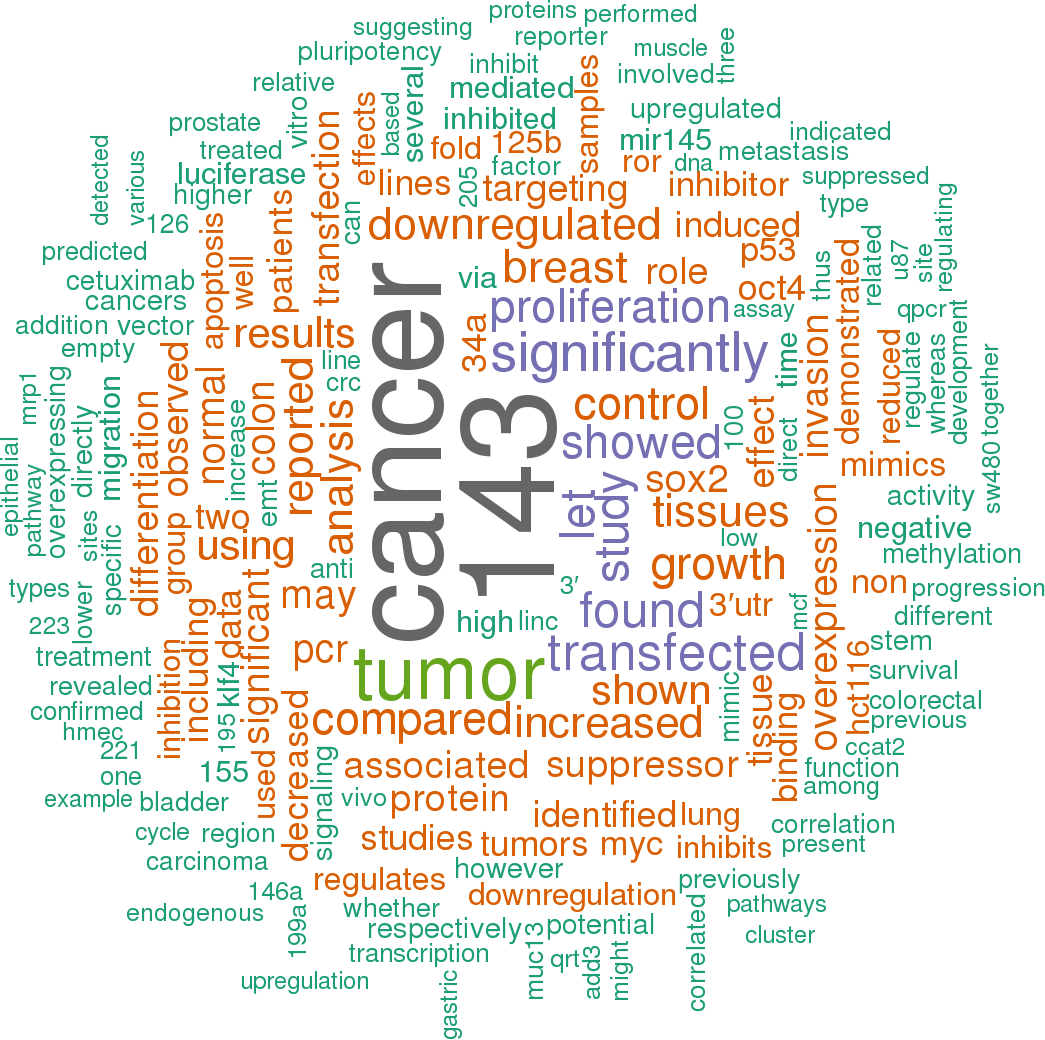Accession
MI0000461
Symbol
HGNC:
MIR145
Description
Homo sapiens
hsa-mir-145 precursor miRNA
Gene family
MIPF0000079;
mir-145
Summary
Caution, this is an AI generated summary based on literature. This may have errors. ?
MIR145 is a microRNA that has been found to be involved in various biological processes and diseases. In diabetic nephropathy (DN) patients, MIR145 levels were significantly higher in urinary extracellular vesicles (uEVs) compared to normoalbuminuric patients, and its levels further increased with the development of proteinuria [PMC9603196]. MIR145 is transcribed as a single precursor molecule along with Mir143 and is known to regulate stem cell pluripotency [PMC7956570]. In mice, the loss of Sox2 leads to an increase in MIR145 levels, which subsequently reduces Sox9 protein levels [PMC3865748]. Promoter hypermethylation of MIR145 has been observed in pituitary tumors compared to normal tissue [PMC7281098]. A logistic regression model including miR-7, miR-126, and MIR145 showed promising results in distinguishing non-small cell lung cancer (NSCLC) patients from controls [PMC6463117]. In an experimental study using mice, the injection of MIR145 into tumors resulted in a reduction in tumor volume [PMC5297811]. Additionally, upregulation of MIR145 has been observed in the blood of patients with idiopathic pulmonary arterial hypertension (IPAH) [PMC4357130]. Furthermore, alterations in the expression of MIR145 have been found upon doxorubicin treatment in breast cancer cells [PMC6679136]. The miR-17-92 cluster has also been shown to promote lung progenitor proliferation [PMC4304179]. Finally, MIR145 has potential as a candidate biomarker for breast cancer diagnosis and its oral application along with other tumor suppressor miRs showed promising results for blocking colon cancer tumorigenesis in mice [PMC6786248] [PMC7147085].
Literature search

668 open access papers mention hsa-mir-145
(4250 sentences)
(4250 sentences)
Sequence
1428617
reads,
20797
reads per million, 150 experiments
caccuuguccucacgGUCCAGUUUUCCCAGGAAUCCCUuagaugcuaagauggGGAUUCCUGGAAAUACUGUUCUugaggucaugguu
.(((.((.(((((.((..((((.((.((((((((((((.............)))))))))))).)).))))..))))))).)).))).
.(((.((.(((((.((..((((.((.((((((((((((.............)))))))))))).)).))))..))))))).)).))).
Structure
c u u c UC U C uagau acc ug ccuca gG CAGU UU CCAGGAAUCCCU g ||| || ||||| || |||| || |||||||||||| c ugg ac ggagu UC GUCA AA GGUCCUUAGGgg u u u u - UU U A uagaa
Annotation confidence
High
Do you think this miRNA is real?
Comments
This miRNA sequence was predicted based on homology to a verified miRNA from mouse [1]. Michael et al. subsequently verified expression of miR-145 in human, and demonstrated significantly reduced levels of the miRNA in precancerous and neoplastic colorectal tissue [2]. The mature sequence shown here represents the most commonly cloned form from large-scale cloning studies [4].
Genome context
chr5: 149430646-149430733 [+]
Clustered miRNAs
1 other miRNA is < 10 kb from hsa-mir-145
| Name | Accession | Chromosome | Start | End | Strand | Confidence |
|---|
Disease association
hsa-mir-145 is associated with one or more human diseases in the Human microRNA Disease Database
| Disease | Description | Category | PubMed ID |
|---|
Biological pathways
hsa-mir-145 is involved in one or more biological pathways:
(Source: Reactome)
(Source: Reactome)
Biological reactions
hsa-mir-145 is involved in one or more regulation/signalling events:
(Source: Reactome)
(Source: Reactome)
Mature hsa-miR-145-5p
| Accession | MIMAT0000437 |
| Description | Homo sapiens hsa-miR-145-5p mature miRNA |
| Sequence | 16 - GUCCAGUUUUCCCAGGAAUCCCU - 38 |
| Evidence |
experimental
cloned [2-4] |
| Database links |



|
| Predicted targets |



|
Mature hsa-miR-145-3p
| Accession | MIMAT0004601 |
| Description | Homo sapiens hsa-miR-145-3p mature miRNA |
| Sequence | 54 - GGAUUCCUGGAAAUACUGUUCU - 75 |
| Evidence |
experimental
cloned [4] |
| Database links |



|
| Predicted targets |



|
References
|




